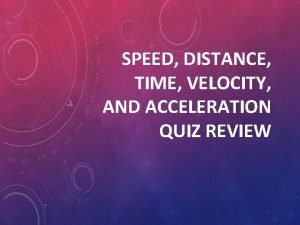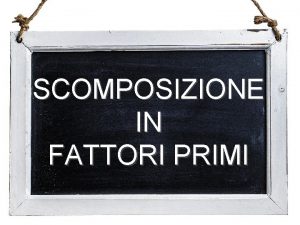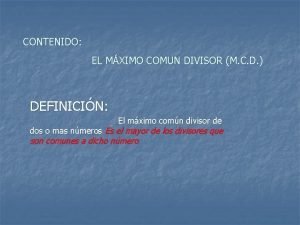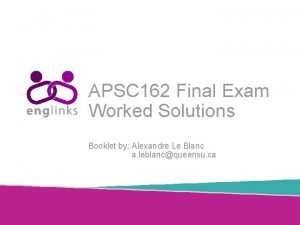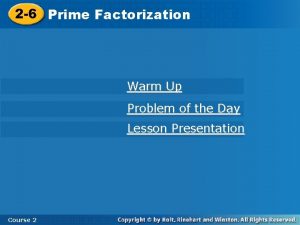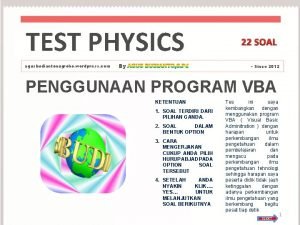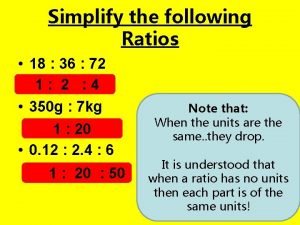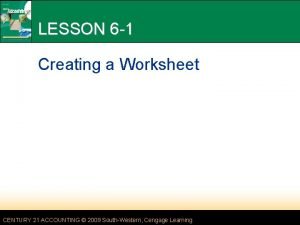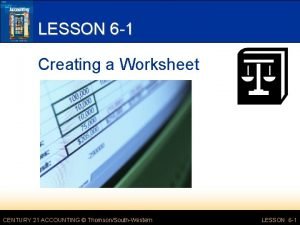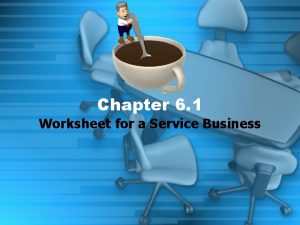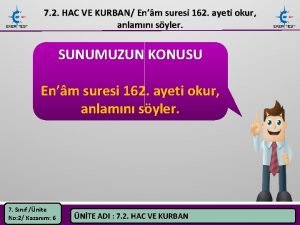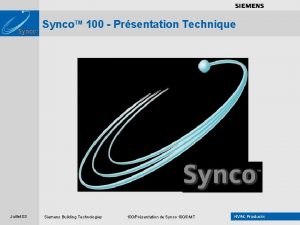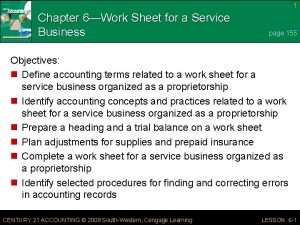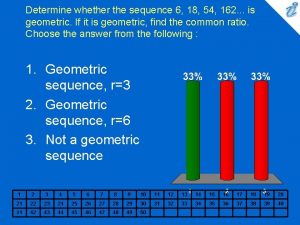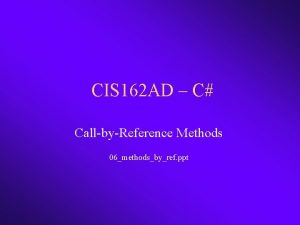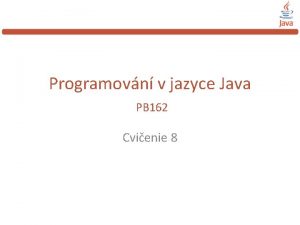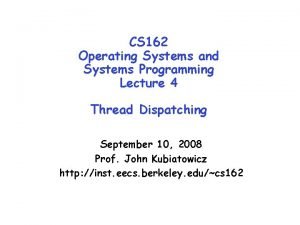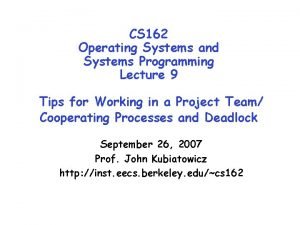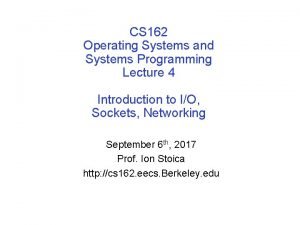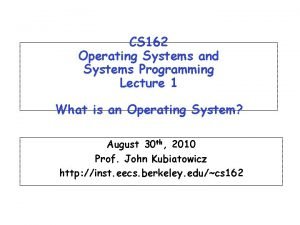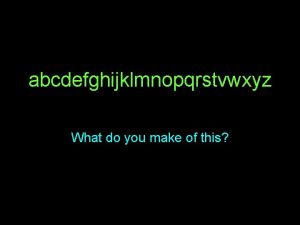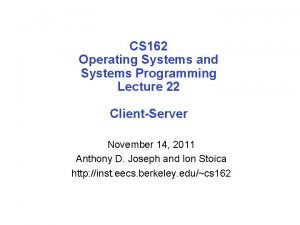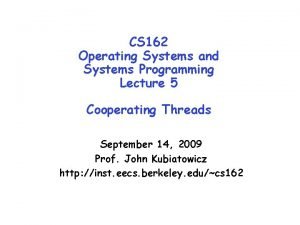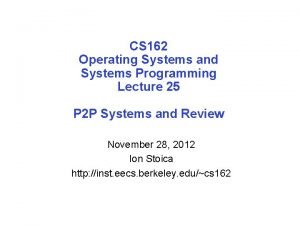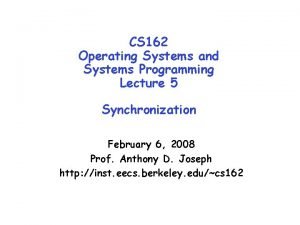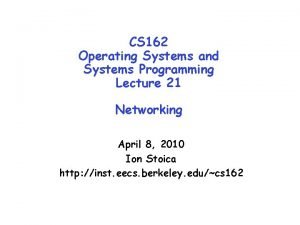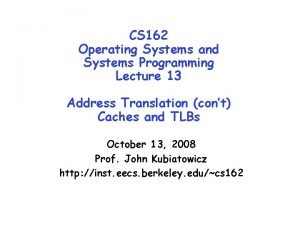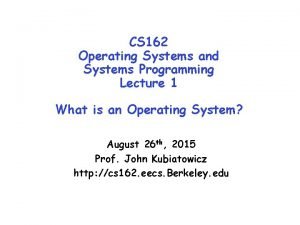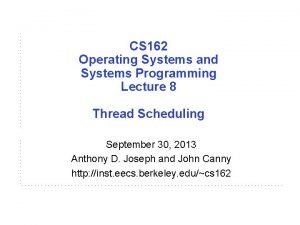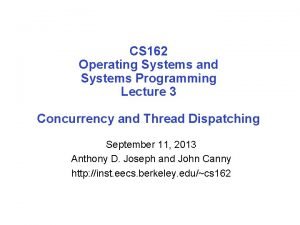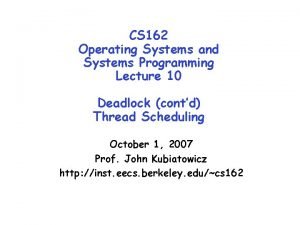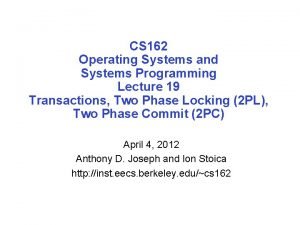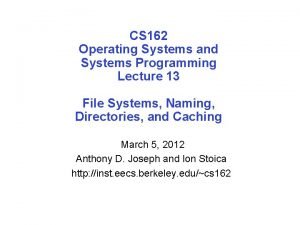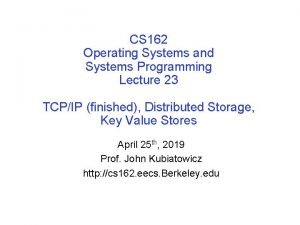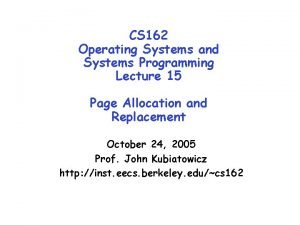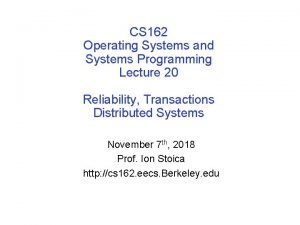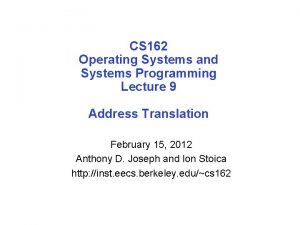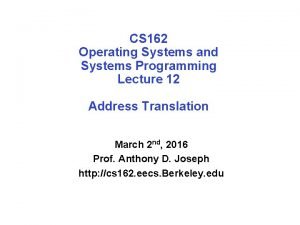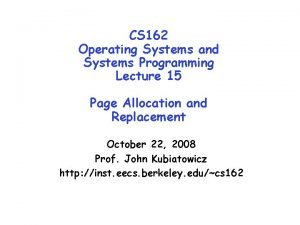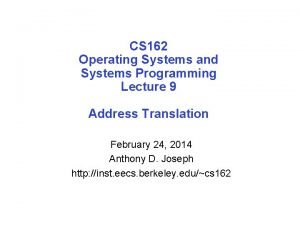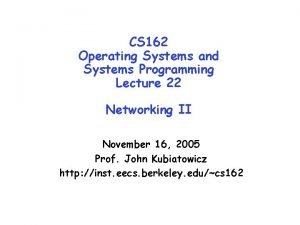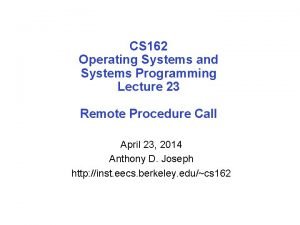CS 162 Operating Systems and Systems Programming Lecture

































- Slides: 33

CS 162 Operating Systems and Systems Programming Lecture 1 What is an Operating System? January 19 th, 2010 Ion Stoica http: //inst. eecs. berkeley. edu/~cs 162

Who am I? Ion Stoica • Research – Networking » Topics: Quality of service, architectures » Projects: Internet Indirection Infrastructure, Declarative Networks – Peer-to-Peer » Topics: distributed hash tables, lookup services » Projects: Chord, Internet Indirection Infrastructure – Cloud computing » Topics: Scheduling, resource management » Projects: Nexus (Cloud OS), Spark – Debugging and Replaying » Projects: Liblog, Friday, ODR (Output Deterministic Replay) 1/19/10 Ion Stoica CS 162 ©UCB Spring 2010 Lec 1. 2

Goals for Today • What is an Operating System? – And – what is it not? • Examples of Operating Systems design • Why study Operating Systems? • Oh, and “How does this class operate? ” Interactive is important! Ask Questions! Note: Some slides and/or pictures in the following are adapted from slides © 2005 Silberschatz, Galvin, and Gagne. Slides courtesy of Kubiatowicz, AJ Shankar, George Necula, Alex Aiken, Eric Brewer, Ras Bodik, Ion Stoica, Doug Tygar, and David Wagner. 1/19/10 Ion Stoica CS 162 ©UCB Spring 2010 Lec 1. 3

Technology Trends: Moore’s Law 2 X transistors/Chip Every 1. 5 years Gordon Moore (co-founder of Intel) predicted in 1965 that the transistor density of semiconductor chips would double roughly every 18 months. 1/19/10 Called “Moore’s Law” Microprocessors have become smaller, denser, and more powerful. Ion Stoica CS 162 ©UCB Spring 2010 Lec 1. 4

Societal Scale Information Systems • The world is a large parallel system – Microprocessors in everything – Vast infrastructure behind them Internet Connectivity Massive Cluster Gigabit Ethernet Clusters Scalable, Reliable, Secure Services Databases Information Collection Remote Storage Online Games Commerce … MEMS for Sensor 1/19/10 Nets Ion Stoica CS 162 ©UCB Spring 2010 Lec 1. 5

People-to-Computer Ratio Over Time From David Culler • Today: Multiple CPUs/person! 1/19/10 – Approaching 100 s? Ion Stoica CS 162 ©UCB Spring 2010 Lec 1. 6

New Challenge: Slowdown in Joy’s law of Performance 3 X From Hennessy and Patterson, Computer Architecture: A Quantitative Approach, 4 th edition, Sept. 15, 2006 Sea change in chip design: multiple “cores” or processors per chip • VAX : 25%/year 1978 to 1986 • RISC + x 86: 52%/year 1986 to 2002 • RISC + x 86: ? ? %/year Ion 2002 to CS 162 present 1/19/10 Stoica ©UCB Spring 2010 Lec 1. 7

Many. Core Chips: The future is here • Intel 80 -core multicore chip (Feb 2007) – – – 80 simple cores Two floating point engines /core Mesh-like "network-on-a-chip“ 100 million transistors 65 nm feature size Frequency Voltage Power Bandwidth Performance 3. 16 GHz 0. 95 V 62 W 1. 62 Terabits/s 1. 01 Teraflops 5. 1 GHz 1. 2 V 175 W 2. 61 Terabits/s 1. 63 Teraflops 5. 7 GHz 1. 35 V 265 W 2. 92 Terabits/s 1. 81 Teraflops • “Many. Core” refers to many processors/chip – 64? 128? Hard to say exact boundary • How to program these? – Use 2 CPUs for video/audio – Use 1 for word processor, 1 for browser – 76 for virus checking? • Parallelism must Ion be. Stoica exploited at all levels CS 162 ©UCB Spring 2010 1/19/10 Lec 1. 8

Another Challenge: Power Density • Moore’s Law Extrapolation – Potential power density reaching amazing levels! • Flip side: Battery life very important – Moore’s law can yield more functionality at equivalent (or less) total energy consumption 1/19/10 Ion Stoica CS 162 ©UCB Spring 2010 Lec 1. 9

Computer System Organization • Computer-system operation – One or more CPUs, device controllers connect through common bus providing access to shared memory – Concurrent execution of CPUs and devices competing for memory cycles 1/19/10 Ion Stoica CS 162 ©UCB Spring 2010 Lec 1. 10

Sample of Computer Architecture Topics Input/Output and Storage Disks, WORM, Tape VLSI Coherence, Bandwidth, Latency L 2 Cache L 1 Cache Instruction Set Architecture Addressing, Protection, Exception Handling Pipelining, Hazard Resolution, Superscalar, Reordering, Prediction, Speculation, Vector, Dynamic Compilation 1/19/10 Network Communication Other Processors Emerging Technologies Interleaving Bus protocols DRAM Memory Hierarchy RAID Pipelining and Instruction Level Parallelism Ion Stoica CS 162 ©UCB Spring 2010 Lec 1. 11

Increasing Software Complexity From MIT’s 6. 033 course 1/19/10 Ion Stoica CS 162 ©UCB Spring 2010 Lec 1. 12

Example: Some Mars Rover (“Pathfinder”) Requirements • Pathfinder hardware limitations/complexity: – 20 Mhz processor, 128 MB of DRAM, Vx. Works OS – cameras, scientific instruments, batteries, solar panels, and locomotion equipment – Many independent processes work together • Can’t hit reset button very easily! – Must reboot itself if necessary – Must always be able to receive commands from Earth • Individual Programs must not interfere – Suppose the MUT (Martian Universal Translator Module) buggy – Better not crash antenna positioning software! • Further, all software may crash occasionally – Automatic restart with diagnostics sent to Earth – Periodic checkpoint of results saved? • Certain functions time critical: – Need to stop before hitting something – Must track orbit of Earth for communication 1/19/10 Ion Stoica CS 162 ©UCB Spring 2010 Lec 1. 13

How do we tame complexity? • Every piece of computer hardware different – Different CPU » Pentium, Power. PC, Cold. Fire, ARM, MIPS – Different amounts of memory, disk, … – Different types of devices » Mice, Keyboards, Sensors, Cameras, Fingerprint readers, touch screen� – Different networking environment » Cable, DSL, Wireless, Firewalls, … • Questions: – Does the programmer need to write a single program that performs many independent activities? – Does every program have to be altered for every piece of hardware? – Does a faulty program crash everything? – Does every program have access to all hardware? 1/19/10 Ion Stoica CS 162 ©UCB Spring 2010 Lec 1. 14

OS Tool: Virtual Machine Abstraction Application Operating System Hardware Virtual Machine Interface Physical Machine Interface • Software Engineering Problem: – Turn hardware/software quirks what programmers want/need – Optimize for convenience, utilization, security, reliability, etc… • For Any OS area (e. g. file systems, virtual memory, networking, scheduling): – What’s the hardware interface? (physical reality) – What’s the application interface? (nicer abstraction) 1/19/10 Ion Stoica CS 162 ©UCB Spring 2010 Lec 1. 15

Interfaces Provide Important Boundaries software instruction set hardware • Why do interfaces look the way that they do? – – History, Functionality, Stupidity, Bugs, Management CS 152 Machine interface CS 160 Human interface CS 169 Software engineering/management • Should responsibilities be pushed across boundaries? – RISC architectures, Graphical Pipeline Architectures 1/19/10 Ion Stoica CS 162 ©UCB Spring 2010 Lec 1. 16

Virtual Machines • Software emulation of an abstract machine – Make it look like hardware has features you want – Programs from one hardware & OS on another one • Programming simplicity – – Each process thinks it has all memory/CPU time Each process thinks it owns all devices Different Devices appear to have same interface Device Interfaces more powerful than raw hardware » Bitmapped display windowing system » Ethernet card reliable, ordered, networking (TCP/IP) • Fault Isolation – Processes unable to directly impact other processes – Bugs cannot crash whole machine • Protection and Portability – Java interface safe and stable across many platforms 1/19/10 Ion Stoica CS 162 ©UCB Spring 2010 Lec 1. 17

Virtual Machines (con’t): Layers of OSs • Useful for OS development – When OS crashes, restricted to one VM – Can aid testing programs on other OSs 1/19/10 Ion Stoica CS 162 ©UCB Spring 2010 Lec 1. 18

Course Administration • Instructor: Ion Stoica (istoica@cs. berkeley. edu) 465 Soda Hall Office Hours(Tentative): TT 2: 00 pm-3: 00 pm • TAs: • Labs: • Website: Webcast: Matei Zaharia Andy Konwinski Benjamin Hindman (cs 162 -ta@cory) (cs 162 -tb@cory) (cs 162 -tc@cory) Second floor of Soda Hall http: //inst. eecs. berkeley. edu/~cs 162 http: //webcast. berkeley. edu/courses/index. php • Newsgroup: ucb. class. cs 162 (use news. csua. berkeley. edu) • Course Email: cs 162@cory. cs. berkeley. edu • Reader: TBA (Stay tuned!) 1/19/10 Ion Stoica CS 162 ©UCB Spring 2010 Lec 1. 19

Class Schedule • Class Time: TT 3: 30 -5: 00 PM, 277 Cory Hall – Please come to class. Lecture notes do not have everything in them. The best part of class is the interaction! – Also: 5% of the grade is from class participation (section and class) • Sections: – Important information is in the sections – The sections assigned to you by Telebears are temporary! – Every member of a project group must be in same section – No sections this week (obviously); start next week Section 101 Time W 10: 00 A-11: 00 A Location 2 Evans TA Matei Zaharia 102 W 2: 00 P-3: 00 P 75 Evans Andy Kowinski 103 W 3: 00 P-4: 00 P 2 Evans Ben Hindman 1/19/10 Ion Stoica CS 162 ©UCB Spring 2010 Lec 1. 20

Textbook • Text: Operating Systems Concepts, 8 th Edition Silbershatz, Galvin, Gagne • Online supplements – See “Information” link on course website – Includes Appendices, sample problems, etc • Question: need 8 th edition? – No, but has new material that we may cover – Completely reorganized – Will try to give readings from both the 7 th and 8 th editions on the lecture page 1/19/10 Ion Stoica CS 162 ©UCB Spring 2010 Lec 1. 21

Topic Coverage Textbook: Silberschatz, Galvin, and Gagne, Operating Systems Concepts, 8 th Ed. , 2008 • • • 1 week: 1. 5 weeks: 2 week: 1 week: 2. 5 weeks: 1 week: ? ? : 1/19/10 Fundamentals (Operating Systems Structures) Process Control and Threads Synchronization and scheduling Protection, Address translation, Caching Demand Paging File Systems Networking and Distributed Systems Protection and Security Advanced topics Ion Stoica CS 162 ©UCB Spring 2010 Lec 1. 22

Grading • Rough Grade Breakdown – One Midterm: 20% each One Final: 25% Four Projects: 50% (i. e. 12. 5% each) Participation: 5% • Four Projects: – – Phase I: III: IV: • Late Policy: Build a thread system Implement Multithreading Caching and Virtual Memory Networking and Distributed Systems – No slip days! – 10% off per day after deadline 1/19/10 Ion Stoica CS 162 ©UCB Spring 2010 Lec 1. 23

Group Project Simulates Industrial Environment • Project teams have 4 or 5 members in same discussion section – Must work in groups in “the real world” • Communicate with colleagues (team members) – – – Communication problems are natural What have you done? What answers you need from others? You must document your work!!! Everyone must keep an on-line notebook • Communicate with supervisor (TAs) – How is the team’s plan? – Short progress reports are required: 1/19/10 » What is the team’s game plan? » What is each member’s responsibility? Ion Stoica CS 162 ©UCB Spring 2010 Lec 1. 24

Typical Lecture Format Attention 20 min. Break 25 min. “In Conclusion, . . . ” Time • • • 1 -Minute Review 20 -Minute Lecture 5 - Minute Administrative Matters 25 -Minute Lecture 5 -Minute Break (water, stretch) 25 -Minute Lecture 1/19/10 Ion Stoica CS 162 ©UCB Spring 2010 Lec 1. 25

Lecture Goal Interactive!!! 1/19/10 Ion Stoica CS 162 ©UCB Spring 2010 Lec 1. 26

Computing Facilities • Every student who is enrolled should get an account form at end of lecture – Gives you an account of form cs 162 -xx@cory – This account is required » Most of your debugging can be done on other EECS accounts, however… » All of the final runs must be done on your cs 162 -xx account and must run on the x 86 Solaris machines • Make sure to log into your new account this week and fill out the questions • Project Information: – See the “Projects and Nachos” link off the course home page • Newsgroup (ucb. class. cs 162): – Read this regularly! 1/19/10 Ion Stoica CS 162 ©UCB Spring 2010 Lec 1. 27

What does an Operating System do? • Silerschatz and Gavin: “An OS is Similar to a government” – Begs the question: does a government do anything useful by itself? • Coordinator and Traffic Cop: – Manages all resources – Settles conflicting requests for resources – Prevent errors and improper use of the computer • Facilitator: – Provides facilities that everyone needs – Standard Libraries, Windowing systems – Make application programming easier, faster, less error-prone • Some features reflect both tasks: – E. g. File system is needed by everyone (Facilitator) – But File system must be Protected (Traffic Cop) 1/19/10 Ion Stoica CS 162 ©UCB Spring 2010 Lec 1. 28

What is an Operating System, … Really? • Most Likely: – – – Memory Management I/O Management CPU Scheduling Communications? (Does Email belong in OS? ) Multitasking/multiprogramming? • What about? – – File System? Multimedia Support? User Interface? Internet Browser? • Is this only interesting to Academics? ? 1/19/10 Ion Stoica CS 162 ©UCB Spring 2010 Lec 1. 29

Operating System Definition (Cont. ) • No universally accepted definition • “Everything a vendor ships when you order an operating system” is good approximation – But varies wildly • “The one program running at all times on the computer” is the kernel. – Everything else is either a system program (ships with the operating system) or an application program 1/19/10 Ion Stoica CS 162 ©UCB Spring 2010 Lec 1. 30

OS Systems Principles • OS as illusionist: – Make hardware limitations go away – Provide illusion of dedicated machine with infinite memory and infinite processors • OS as government: – Protect users from each other – Allocate resources efficiently and fairly • OS as complex system: – Constant tension between simplicity and functionality or performance • OS as history teacher – Learn from past – Adapt as hardware tradeoffs change 1/19/10 Ion Stoica CS 162 ©UCB Spring 2010 Lec 1. 31

Why Study Operating Systems? • Learn how to build complex systems: – How can you manage complexity for future projects? • Engineering issues: – Why is the web so slow sometimes? Can you fix it? – What features should be in the next mars Rover? – How do large distributed systems work? (Bittorrent, etc) • Buying and using a personal computer: – Why different PCs with same CPU behave differently – How to choose a processor (Opteron, Itanium, Celeron, Pentium) – Should you get Windows XP, 2000, Linux, Mac OS …? • Business issues: – Should your division buy thin-clients vs PC? • Security, viruses, and worms – What exposure do you have to worry about? 1/19/10 Ion Stoica CS 162 ©UCB Spring 2010 Lec 1. 32

“In conclusion…” • Operating systems provide a virtual machine abstraction to handle diverse hardware • Operating systems coordinate resources and protect users from each other • Operating systems simplify application development by providing standard services • Operating systems can provide an array of fault containment, fault tolerance, and fault recovery • CS 162 combines things from many other areas of computer science – – Languages, data structures, hardware, and algorithms 1/19/10 Ion Stoica CS 162 ©UCB Spring 2010 Lec 1. 33
 Advanced operating system notes
Advanced operating system notes 01:640:244 lecture notes - lecture 15: plat, idah, farad
01:640:244 lecture notes - lecture 15: plat, idah, farad C data types with examples
C data types with examples What is the prime factorization of 80 using exponents
What is the prime factorization of 80 using exponents A man rode on his motorcycle for 162 miles
A man rode on his motorcycle for 162 miles Scomposizione in fattori primi del numero 240
Scomposizione in fattori primi del numero 240 Lcm of 90 and 30
Lcm of 90 and 30 Mcd de 21 y 49
Mcd de 21 y 49 Apsc 162
Apsc 162 Factorization of 162
Factorization of 162 Komulator
Komulator Simplify the ratios 18 is 72 is 162
Simplify the ratios 18 is 72 is 162 6-1 work together p. 162 answers
6-1 work together p. 162 answers 6-1 work together p. 162 answers
6-1 work together p. 162 answers 6-1 work together p. 162 answers
6-1 work together p. 162 answers 7 sınıf en'âm suresi 162. ayet
7 sınıf en'âm suresi 162. ayet Rle 162
Rle 162 6-1 work together p. 162
6-1 work together p. 162 2 6 18 54 162 sequence
2 6 18 54 162 sequence 162 ad
162 ad Pb162
Pb162 Cs 162
Cs 162 C++ language
C++ language Cs 162
Cs 162 Cs 162
Cs 162 Fourth root of 162
Fourth root of 162 Perbedaan linear programming dan integer programming
Perbedaan linear programming dan integer programming Greedy vs dynamic programming
Greedy vs dynamic programming What is system programing
What is system programing Linear vs integer programming
Linear vs integer programming Definisi integer
Definisi integer Can we make operating systems reliable and secure
Can we make operating systems reliable and secure Operating system internals and design principles
Operating system internals and design principles Module 4 operating systems and file management
Module 4 operating systems and file management




